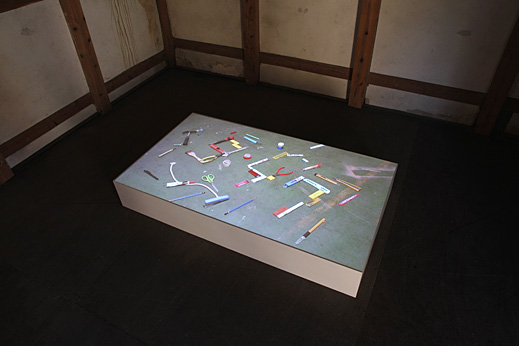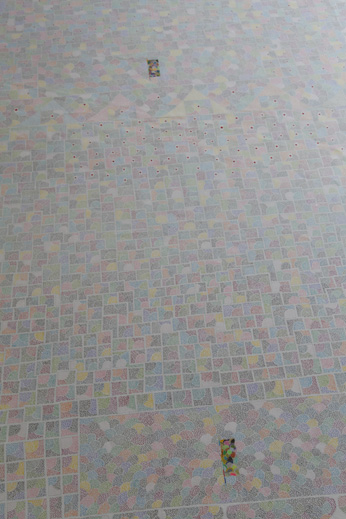 |
Hiroaki Morita, Clockwise (2005-2008), courtesy AOYAMA | MEGURO
Photo: Keizo Kioku |
|
|
Art by the mentally and physically handicapped has become increasingly popular over the last several years. Unlike its foreign counterparts, however, "outsider art" in Japan is almost invariably linked to a care facility which organizes creative activities for its residents and in some cases acts as an agent for their work. Though this trend and the tendency to place artists in one of two boxes -- "in" or "out" -- is somewhat worrying, Touch the World, through March 7, 2010 at the Borderless Art Museum NO-MA, is a reassuring step in the right direction.
Comprising about two dozen pieces by eight artists, the exhibition is defined by its inclusion of both internationally active "insiders" and "outsiders" whose sphere is limited to the confines of a mental hospital. Several generations are also represented, with one artist young enough to be in high school and the oldest closing in on the century mark. All of this is very much on the viewer's mind upon entering the museum but quickly forgotten thanks to the avoidance of biography -- which so often overwhelms the work of "outside" artists -- by Kenjiro Hosaka, a curator at the National Museum of Modern Art, Tokyo, and to his seamless way of making wholly unexpected connections.
The museum, situated in Omi Hachiman, a quaint town known for its modern architecture and lip balm on the shores of Lake Biwa in Shiga Prefecture, occupies a partially renovated machiya (once home to the Noma family) in a quiet residential neighborhood. Opened in 2004 and managed by a prefectural welfare organization, NO-MA is now the foremost outlet for "outsider art" in the country and, through various alliances with pioneering venues like the Collection de l'Art Brut in Switzerland, has helped organize international exhibitions such as Art Brut Japonais, scheduled to be held in Paris later this year. The museum's remote location is explained in part by Shiga's progressive social outlook -- its female governor was elected on a platform of halting construction on a proposed bullet train station; its libraries enjoy the highest per-capita circulation in the country; and its education and art programs for the handicapped, developed immediately after World War II, are the oldest of their kind in Japan.
 |
Hironobu Matsumoto, Picture Scroll of a Battlefield (Detail) (2009)
Photo: Keizo Kioku |
The current exhibition sets out to consider "this world" in respect to each individual's "inner world," and attempts to find points at which the two intersect. This rather vague objective assumes a distinct form in a collection of works that are highly personal in nature yet universal in application.
Sisui Akiba's paintings, which at first glance betray little more than a dark haze of gray horizontal stripes, sometimes include a human figure, with the most minimal features, dissolving into the background. Other times, in a work like Toward, the viewer seems to have arrived too late -- the disappearing act is complete and the form has been enveloped or has willingly entered the void.
Concealment and discovery are central to Yuki Okumura's two-part video work Echoes: A Small Concert for Lina and Saya, which unfolds first in a projection at the top of the stairs and is completed on a monitor in a living room-like tatami space on the second floor. In the first, a man is shown blowing his trumpet into a tin can embedded in a pillar in the center of a room, while in the second, two young girls press their ears to a similar opening in the wall of a separate room to take in the performance. With a slight time lag between the two, the viewer is given special access to both sides of the action, and unlike the work's protagonists, is present both "here" and "there," "now" and "then."
In what is in many ways the exhibition's showpiece, Clockwise, the viewer's attention is drawn back to the more immediate concerns of "here" and "now." Installed in a white-walled kura storehouse in the museum's garden, Hiroaki Morita's video work, projected vertically from the ceiling onto a small platform, depicts a clutter of mechanical pencils, scissors, and other hand tools arranged in a geometrical pattern, the meaning of which is not immediately discernible. Within sixty seconds, however, the objects come to life and pivot around the space to display a set of numbers like "11:46." Time, as expressed by this set of objects designed to impart shape and color, just keeps ticking.
Thanks to this and many other examples of straightforward, often charming art, the viewer is assured a fine day out.
The Borderless Art Museum NO-MA can be accessed by Omi Tetsudo bus, bound for Chomei-ji, from JR Omi Hachiman Station. The museum is a ten-minute walk from the Osugi bus stop. It is open daily except Monday (or Tuesday if Monday is a national holiday) from 10:00 to 17:00. Admission is 500 yen. For more information, call 0748-31-2481 or visit the museum's English web page below.
|